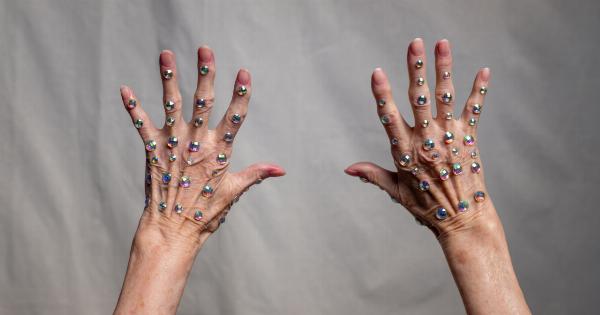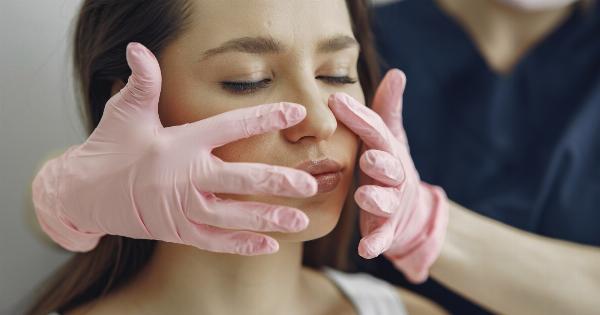Menopause is a natural transition that every woman experiences as she reaches middle age. This life stage is characterized by hormonal fluctuations and changes that can impact various aspects of a woman’s health, including her skin.
Many women struggle with skin-related issues during menopause, such as dryness, dullness, and the loss of that youthful glow.
The Effects of Menopause on Facial Skin
During menopause, the production of estrogen decreases significantly. Estrogen is a hormone that plays a vital role in maintaining healthy skin. Its decline can lead to several skin-related changes, including:.
- Dryness and dehydration
- Loss of elasticity
- Wrinkles and fine lines
- Uneven skin tone and pigmentation
- Increased sensitivity
- Slower skin cell turnover
These changes can make your skin appear dull, lackluster, and aged. Luckily, there are several steps you can take to achieve a glowing face during menopause.
1. Prioritize Skincare
Investing in a comprehensive skincare routine is crucial during menopause. Start by cleansing your face twice a day with a gentle cleanser that doesn’t strip away natural oils.
Follow up with a hydrating toner to rebalance your skin’s pH level.
Next, incorporate a serum rich in antioxidants and hyaluronic acid to combat dryness and increase moisture retention.
Consider using a night cream that contains ingredients like retinol or peptides, which can help stimulate collagen production and reduce the appearance of wrinkles.
Don’t forget to apply sunscreen with a minimum SPF of 30 during the day to protect your skin from harmful UV radiation.
2. Hydrate Your Skin from Within
Drinking an adequate amount of water is essential for good overall health and hydration. Proper hydration helps maintain the moisture balance in your skin, keeping it plump and supple.
Include foods rich in omega-3 fatty acids, such as salmon and chia seeds, in your diet. These healthy fats help strengthen your skin’s natural barrier, preventing moisture loss.
You can also consider incorporating a hydrating mask into your skincare routine a few times a week to provide an extra boost of moisture to your skin.
3. Eat a Balanced Diet
Opt for a diet that includes a variety of fruits, vegetables, whole grains, lean proteins, and healthy fats. These nutrient-rich foods provide essential vitamins and minerals that contribute to healthy skin.
Focus on foods rich in antioxidants, such as berries, leafy greens, and brightly colored vegetables. Antioxidants help protect your skin against free radicals, which can accelerate the aging process.
Include foods high in vitamins A, C, and E, which promote collagen production and help improve skin elasticity. Citrus fruits, bell peppers, spinach, almonds, and avocados are excellent sources of these vitamins.
4. Manage Stress
Menopause, coupled with the challenges of daily life, can bring about increased stress levels. Chronic stress can negatively impact your skin health, leading to breakouts, dryness, and inflammation.
Find stress management techniques that work for you, such as yoga, meditation, deep breathing exercises, or engaging in hobbies that bring you joy and relaxation.
Ensure you’re getting enough restful sleep, as lack of sleep can further affect your skin’s appearance and hinder its ability to repair and regenerate.
5. Exercise Regularly
Engaging in regular physical activity has numerous benefits for your overall health, including your skin. Exercise promotes blood circulation, delivering oxygen and nutrients to your skin cells, giving your face a healthier and more radiant appearance.
It’s advisable to choose activities that increase your heart rate and make you break a sweat. This can be running, brisk walking, cycling, or any other form of aerobic exercise that suits your preferences.
Remember to cleanse your face thoroughly after exercising to remove sweat and dirt that can clog your pores.
6. Be Mindful of Hot Flashes
Hot flashes are a common symptom of menopause and can cause your face to appear flushed and sweaty. These sudden surges of heat can aggravate certain skin conditions, such as rosacea.
Avoid triggers that can induce hot flashes, such as spicy foods, hot drinks, alcohol, and stress. Dress in layers and keep your surroundings cool to help manage the frequency and intensity of hot flashes.
7. Seek Professional Treatments
If you’re struggling with more severe skin concerns, seeking professional treatments can be beneficial. Consider consulting a dermatologist or aesthetician experienced in treating menopausal skin.
They may recommend treatments such as chemical peels, microdermabrasion, laser therapy, or dermal fillers to address specific issues like discoloration, wrinkles, or sagging skin.
8. Quit Smoking
Smoking is known to have detrimental effects on the skin, accelerating the aging process. It reduces blood flow to the skin and depletes it of essential nutrients, leading to wrinkles, dullness, and a lack of radiance.
Quitting smoking not only improves your skin’s appearance, but it also benefits your overall health and reduces the risk of various diseases.
9. Use Makeup Strategically
While skincare should be your primary focus, using makeup strategically can enhance your natural glow during menopause.
Choose lightweight, hydrating foundations or tinted moisturizers to provide coverage while adding a dewy finish to your skin. Opt for cream-based blushes and highlighters to create a youthful, radiant look.
Avoid heavy powders that can settle into fine lines and exacerbate dryness. Instead, use translucent powders sparingly only in areas with excess shine.
10. Embrace a Positive Mindset
Menopause is a unique and transformative stage in a woman’s life. Approaching it with a positive mindset, embracing the changes, and practicing self-care can significantly impact your overall well-being, including your skin.
Remember that true beauty comes from within, and having confidence and self-love can radiate through your face, making it glow.





























